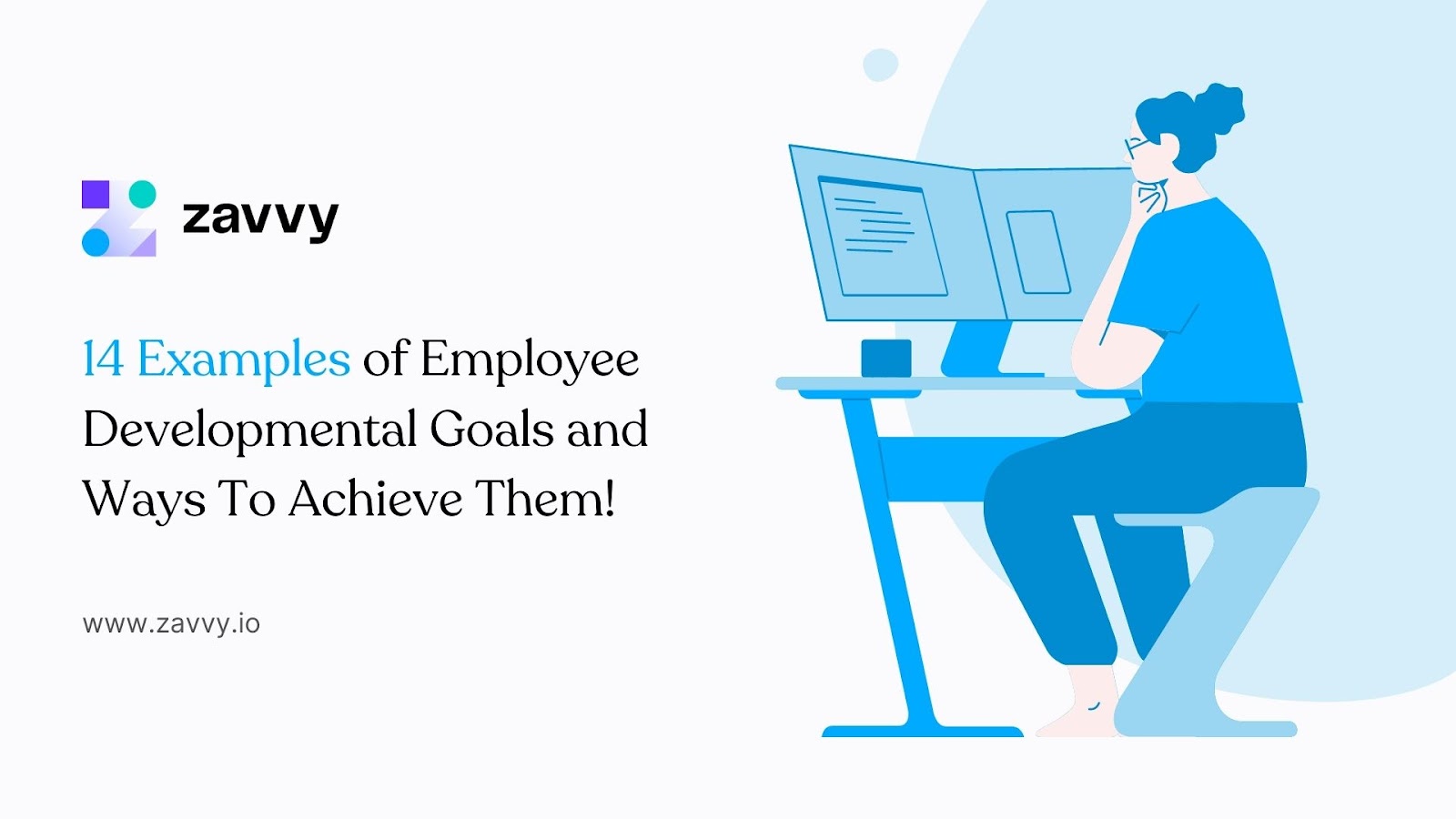
Alexander Heinle
Alex is a marketer at Zavvy. On this blog, he mainly shares insights gained from discussions with selected experts and from helping our customers set up and improve their onboarding or learning programs.


A successful career path requires self-reflection, an understanding of your strengths, weaknesses, and thorough planning of your developmental goals. Think of professional goals as stepping stones to a successful career. They help employees acquire new skills, find happiness at work and add meaning to what they do.
Read on to see what developmental goals are, top examples, and how to get started at your company.
Together with our curators, we have created a library of actionable digital marketing resources. Personalized to your team's needs.
Developmental goals are objectives people plan for themselves to reach the next level in their careers. They're a great way to learn new skills, discover career ambitions, and improve character.
Developmental goals are the foundation on which people build their careers, preparing them for any unforeseen challenges. They're ideas that will invite new opportunities and put your career in proper perspective.
According to HBR, Professional development takes three primary forms: learning, connecting and creating.
We will further discuss this in detail under the section: How to set professional goals.
There's a plethora of podcasts, TED Talks, and motivational books available on building a successful career.
But too often, they're all passive and everything but actionable.
This makes it more critical to plan and manage developmental goals. They're a faster, tangible, and actionable way to maximize people's potential and accelerate overall growth.
Let's look at some more reasons to plan developmental goals:
Having an individual developmental goal helps know how much time to dedicate to each task, identify what's essential for your growth, and focus on areas that need work.
Whether you're an intern or an executive, these goals form a strong foundation for building a successful career.
Once someone is on a path to achieving developmental goals, it will enable them to understand different work areas.
For instance, as people learn new skills, they will be able to participate in various projects, have more responsibilities, and become key players in their team.
Once you create a roadmap, a.k.a, a development plan, you will better understand your skill gaps and how to fulfill and ace them. In addition, they encourage you to take actionable steps to play to your strengths.
This is based on a simple principle:
The better people get at their work, the more productive they will be. In addition, they will be recognized and rewarded for their efforts, motivating them to go the extra mile to achieve their goals.
If you're early in your career, it's normal not to have clarity on where you see yourself growing. This is where developmental goals come into play. They encourage skill improvement and help you take small, actionable steps in the right direction.
Personal and Professional goals are two sides of the same coin– both helping you grow as an individual but in different areas of life.
For example:
A balance of both offers happiness and gratification, motivating you to continue pursuing them.
If you are getting started with planning your developmental goals, dividing them between short-term and long-term is an excellent way to start. It will provide you with some clarity regarding what to prioritize.
Let's understand the differences between the two:
A short-term developmental goal is one you see yourself achieving soon. They can take up to 1 week or three months to complete.
For example: Join a 3-month Bootcamp program on brand strategy. They are much easier to commit to and directly tied to one's effort.
Short-term developmental goals can also be stepping stones, culminating in achieving a long-term goal.
Long-term developmental goals require a lot more planning. It can take as much as one year to see the results. For example, get promoted to a managerial position or start my own business.
One might/might not necessarily be able to achieve long-term goals, as they are also dependent on external factors like opportunities, management team, team structure, etc.
Start writing down where you are and where you see yourself growing in the next 2 to 5 years. Once you have a list of things you want to achieve, shortlist them based on priority.
For instance: if you're expecting a promotion, you'd like to focus on improving your leadership skills than learning new technology.
Here's an example of a great from/to statement:
From an individual contributor who is a key team player with expertise in UI/UX design to a people leader who can drive people to perform better and deliver successful results.
Do a SWOT analysis, reference your latest performance review, and understand areas that need improvement. Then, ask yourself: Are there areas you're not sufficiently performing in your job?
You can also have a 1:1 with your mentor/manager, who can offer guidance and direction on ways you can achieve your goals.
Or even better, map out a skills matrix for yourself–here's a free template!
Following the SMART method (Specific, Measurable, Relevant, and Time-bound goals
will allow you to determine what needs to be focused on, how much time, and what impact it will have on your performance.
They are a great way to stay focused and track the progress of your goal.
Connect with influential people in your organization and share your developmental goals with them. Get some insights on how you can closely align your goals with those of an organization.
Alternatively, you can also look outside your organization. For example, connect with the best people in your field, request an interview, ask for insights.
Ask questions like: "What are some key challenges you faced in your position and how did you overcome them?" or "What qualities would stand out in a resume for someone applying for _______ job position."
Here, you need to develop a growth mindset and understand how to grow most successfully. It would be best to be more proactive with your approach rather than waiting for an opportunity to arrive.
Connect your goals with concrete actions in a career development plan. This is your roadmap for achieving your goals.

If you're aspiring to become a team leader/manager, you'll face challenges like team conflicts, increased workload, miscommunication, etc.
Such situations will test your ability to manage people.
Learning to bring your team together is essential to ensure a smooth flow of communication at work. Get to know each one personally, understand your employees' needs and responsibilities, and build a system where they all can work in harmony towards a common goal.
Employees look up to their leaders for guidance and credible feedback. Therefore, being an influential manager who can offer advice is critical in today's work environment.
Crisis management starts with prevention. Then, while one cannot foresee it, you can take steps to minimize its impact. Leading your team through crisis calls for making immediate choices, being present, and reallocating your resources.
"Leadership is using the greatness in you to achieve and sustain extraordinary outcomes by engaging the greatness in others." Susan L. Colantuono, founder of Leading Woman.
Today's leaders need to leverage their skills to engage and grow people around them in an inclusive way. You will then be able to build a workforce where everyone feels empowered, valued, and supported–vital elements of thriving work culture.
Leadership is a continuous process that needs to be learned, practiced, and evolved with time. Enrolling in leadership programs like executive MBA prepares you for new challenges, builds a versatile network of professionals, and updates you with the latest trends.
84% of executives agree that innovation is essential to growing their companies. But, less than 10% know how to improve their innovation efforts, according to research from Mckinsey.
As a business leader, you need to prioritize keeping up with/updating their technology. Not only will this put your organization ahead of the competition, but it will also streamline your workflows.
Mutual trust and respect between leaders and employees is the foundation of success for thriving organizations. If you want to foster a culture of open communication and teamwork, you need to embody these values first.
Only then will your people be motivated to follow in your footsteps and imbibe similar traits.
"You should lead by example and not illustrate how turbulent times may be affecting you on a personal level." - Daniel Snow, CEO, and founder of The Snow Agency.
How to achieve this goal:

Having a robust professional network opens new opportunities for career advancement. Connecting with the right people also introduces you to new perspectives, ideas, skill development, and more.
How to achieve this goal:
Your first job comes with the excitement of participating in several projects and make a lasting first impression. This is especially the case for startups with dynamic work environments where they expect you to take responsibilities from the get-go.
This makes it crucial for you to master time management skills. Otherwise, it can lead to burnout, inefficiency, and anxiety if not practiced.
Adopting a curious and growth mindset can lead the way to solving new challenges. This makes your job exciting and breaks the monotony of mundane tasks.
Take the initiative to talk to your boss about involving yourself in different projects, bringing new perspectives, or any other opportunity that could lead to career growth.
Delivering and managing day-to-day work on time is an excellent trait to have. However, it could also put a setback on your career.
For instance, you will be stuck with mundane tasks and fall into a routine. This might thwart your creativity, problem-solving skills, and excitement about your job.
Being proactive positively influences your productivity and success and will put you ahead of your colleagues.
If you're at the beginning of your career, this is the time to make mistakes and learn from them. Striving for excellence should be practiced from the start, no matter the scale of your project.
Turning your biggest weakness into a strength is one of the key abilities that impress employers. It shows that you are self-aware, resilient, and a committed employee.
Many of us go through the dilemma of not knowing what the best career move is. There's no assurance that one will find happiness and gratification in their job unless they practice it in real life. If you've realized this early on, it's time to plan your career switch.

Believing in your employees' aspirations builds a positive impression, work culture, and a strong workforce. Here are some ways you can assist your people in achieving their goals:

This easy-to-use template saves you time setting up a development plan structure yourself.
Think of this as your blueprint for your developmental goals.
This development plan template includes your "from" and "to," an essential development framework, including focus areas, SMART goals, concrete actions, and deadlines.
Intentional learning and development is about bringing more out of yourself.
Setting too many goals often leads to distraction and pressure and slows your progress. Reason why, we always recommend you to start small.
You can always build and evaluate your goals in the future. This makes it easier to achieve long-term goals without feeling overwhelmed.
For continuous development, you need a centralized platform where you can customize, plan, and track your goals.

We at Zavvy are committed to propelling your growth through customized developmental plans, and templates like skills matrix, and training needs assessment.
Curious about running a full-on development framework at your company? Talk to our experts for a quick demo!
Upskill your team every week with the best contents and personalized recommendations.

A successful career path requires self-reflection, an understanding of your strengths, weaknesses, and thorough planning of your developmental goals. Think of professional goals as stepping stones to a successful career. They help employees acquire new skills, find happiness at work and add meaning to what they do.
Read on to see what developmental goals are, top examples, and how to get started at your company.
Get a demo!
We'll be happy to show you around and answer all your questions.
Trusted by innovative companies



We'll be happy to show you around, answer your questions, or arrange a free trial.
Erhalten Sie eine kostenlose Demo unserer Onboarding-Software.
Vertraut von



Your Training & Development Strategy - Solved in 1 Tool.
Trusted by innovative companies



We'll be happy to show you around, answer your questions, or arrange a free trial.
Learn how Zavvy helps you drive performance, development, and engagement.
Trusted by innovative companies



We'll be happy to show you around, answer your questions, or arrange a free trial.
We'll be happy to show you around and answer all your questions.
Trusted by innovative companies



We'll be happy to show you around, answer your questions, or arrange a free trial.
Gerne zeigen wir Ihnen ganz unverbindlich unsere Plattform im Detail.
Vertraut von modernen Unternehmen



Get a demo!
We'll be happy to show you around and answer all your questions.
Trusted by innovative companies



We'll be happy to show you around, answer your questions, or arrange a free trial.
Erhalten Sie eine kostenlose Demo unserer Software für Mitarbeiterenwicklung und Training.
Moderne Unternehmen
setzen auf Zavvy


